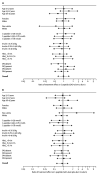Antigen-based therapy with glutamic acid decarboxylase (GAD) vaccine in patients with recent-onset type 1 diabetes: a randomised double-blind trial
- PMID: 21714999
- PMCID: PMC3580128
- DOI: 10.1016/S0140-6736(11)60895-7
Antigen-based therapy with glutamic acid decarboxylase (GAD) vaccine in patients with recent-onset type 1 diabetes: a randomised double-blind trial
Abstract
Background: Glutamic acid decarboxylase (GAD) is a major target of the autoimmune response that occurs in type 1 diabetes mellitus. In animal models of autoimmunity, treatment with a target antigen can modulate aggressive autoimmunity. We aimed to assess whether immunisation with GAD formulated with aluminum hydroxide (GAD-alum) would preserve insulin production in recent-onset type 1 diabetes.
Methods: Patients aged 3-45 years who had been diagnosed with type 1 diabetes for less than 100 days were enrolled from 15 sites in the USA and Canada, and randomly assigned to receive one of three treatments: three injections of 20 μg GAD-alum, two injections of 20 μg GAD-alum and one of alum, or 3 injections of alum. Injections were given subcutaneously at baseline, 4 weeks later, and 8 weeks after the second injection. The randomisation sequence was computer generated at the TrialNet coordinating centre. Patients and study personnel were masked to treatment assignment. The primary outcome was the baseline-adjusted geometric mean area under the curve (AUC) of serum C-peptide during the first 2 h of a 4-h mixed meal tolerance test at 1 year. Secondary outcomes included changes in glycated haemoglobin A(1c) (HbA(1c)) and insulin dose, and safety. Analysis included all randomised patients with known measurements. This trial is registered with ClinicalTrials.gov, number NCT00529399.
Findings: 145 patients were enrolled and treated with GAD-alum (n=48), GAD-alum plus alum (n=49), or alum (n=48). At 1 year, the 2-h AUC of C-peptide, adjusted for age, sex, and baseline C-peptide value, was 0·412 nmol/L (95% CI 0·349-0·478) in the GAD-alum group, 0·382 nmol/L (0·322-0·446) in the GAD-alum plus alum group, and 0·413 nmol/L (0·351-0·477) in the alum group. The ratio of the population mean of the adjusted geometric mean 2-h AUC of C-peptide was 0·998 (95% CI 0·779-1·22; p=0·98) for GAD-alum versus alum, and 0·926 (0·720-1·13; p=0·50) for GAD-alum plus alum versus alum. HbA(1c), insulin use, and the occurrence and severity of adverse events did not differ between groups.
Interpretation: Antigen-based immunotherapy therapy with two or three doses of subcutaneous GAD-alum across 4-12 weeks does not alter the course of loss of insulin secretion during 1 year in patients with recently diagnosed type 1 diabetes. Although antigen-based therapy is a highly desirable treatment and is effective in animal models, translation to human autoimmune disease remains a challenge.
Funding: US National Institutes of Health.
Copyright © 2011 Elsevier Ltd. All rights reserved.
Figures






Comment in
-
Arresting type 1 diabetes after diagnosis: GAD is not enough.Lancet. 2011 Jul 23;378(9788):291-2. doi: 10.1016/S0140-6736(11)60978-1. Epub 2011 Jun 27. Lancet. 2011. PMID: 21715000 No abstract available.
References
-
- Atkinson MA, Eisenbarth GS. Type 1 diabetes: new perspectives on disease pathogenesis and treatment. Lancet. 2001;358:221–229. - PubMed
-
- Palmer JP, Fleming GA, Greenbaum CJ, Herold KC, Jansa LD, Kolb H, et al. C-peptide is the appropriate outcome measure for type 1 diabetes clinical trials to preserve beta-cell function: report of an ADA workshop, 21-22 October 2001 Diabetes. 2004;53:250–264. - PubMed
-
- Diabetes Control and Complications Trial Research Group: Effect of intensive therapy on residual beta-cell function in patients with type 1 diabetes in the diabetes control and complications trial: a randomized, controlled trial. Ann Intern Med. 1998;128:517–523. - PubMed
-
- Steffes MW, Sibley S, Jackson M, Thomas W, Steffes MW, Sibley S, et al. Beta-cell function and the development of diabetes-related complications in the diabetes control and complications trial. Diabetes Care. 2003;26:832–836. - PubMed
-
- Feutren G, Assan R, Karsenty G, Du Rostu H, Sirmai J, Papoz L, et al. Cyclosporin increases the rate and length of remission in insulin-dependent diabetes of recent onset: results of a multicentre double-blind trial. Lancet. 1986;328:119–124. - PubMed
Publication types
MeSH terms
Substances
Associated data
Grants and funding
- M01 RR000400/RR/NCRR NIH HHS/United States
- UL1 RR024139/RR/NCRR NIH HHS/United States
- UL1 RR031986/RR/NCRR NIH HHS/United States
- U01 DK085463/DK/NIDDK NIH HHS/United States
- U01 DK061055/DK/NIDDK NIH HHS/United States
- U01 DK061036/DK/NIDDK NIH HHS/United States
- UL1 RR025744/RR/NCRR NIH HHS/United States
- UL1 TR001085/TR/NCATS NIH HHS/United States
- U01 DK061042/DK/NIDDK NIH HHS/United States
- U01 DK061041/DK/NIDDK NIH HHS/United States
- UC4 DK117009/DK/NIDDK NIH HHS/United States
- HHSN267200800019C/LM/NLM NIH HHS/United States
- U01 DK061010/DK/NIDDK NIH HHS/United States
- U01 DK084565/DK/NIDDK NIH HHS/United States
- UL1 RR025761/RR/NCRR NIH HHS/United States
- U01 DK061040/DK/NIDDK NIH HHS/United States
- UL1 RR024153/RR/NCRR NIH HHS/United States
- UL1 RR029890/RR/NCRR NIH HHS/United States
- U01 DK085466/DK/NIDDK NIH HHS/United States
- U01 DK061058/DK/NIDDK NIH HHS/United States
- U01 DK085505/DK/NIDDK NIH HHS/United States
- U01 DK085453/DK/NIDDK NIH HHS/United States
- UL1 RR025780/RR/NCRR NIH HHS/United States
- UL1 RR024131/RR/NCRR NIH HHS/United States
- M01 RR00400/RR/NCRR NIH HHS/United States
- U01 DK085499/DK/NIDDK NIH HHS/United States
- UL1 RR024982/RR/NCRR NIH HHS/United States
- U01 DK061016/DK/NIDDK NIH HHS/United States
- U01 DK061034/DK/NIDDK NIH HHS/United States
- U01 DK085461/DK/NIDDK NIH HHS/United States
- U01 DK085509/DK/NIDDK NIH HHS/United States
- UL1 RR024975/RR/NCRR NIH HHS/United States
LinkOut - more resources
Full Text Sources
Other Literature Sources
Medical
Miscellaneous

